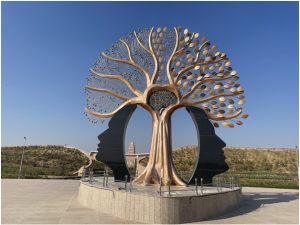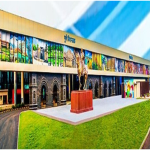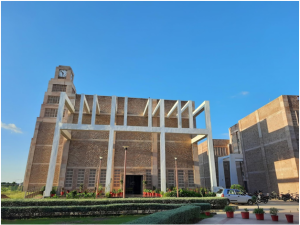The team has identified a promising single-atom catalysts for Nitrogen Reduction Reaction in order to synthesize green ammonia.
The research team has also depicted a possible catalytic mechanism for the production of environmentally friendly ammonia.
Ammonia is one of the key elements in the fertilizer industry as well as in paper, textile, and rubber industries.
TTT NEWS NETWORK
JODHPUR , 26 SEPTEMBER 2023:
From Fertiliser to fuel, green ammonia can become a game changer in climate control globally in the years to come, feels scientists.
Indian Institute of Technology (IIT) Jodhpur researcher Dr. Amitava Banerjee along with his team has identified promising single-atom catalysts for Nitrogen Reduction Reaction (NRR) required for the synthesis of “Green Ammonia”. At present, the conventional process of synthesizing green ammonia has an enormous carbon footprint, as it emits ~3% of global carbon dioxide and consumes ~2% of the world’s total energy production. Electrochemical synthesis route could be a vital choice for its synthesis, where Nitrogen Reduction Reaction (NRR) is one of the hardest reactions to carry out due to the strong N-N triple bond coupled with poor nitrogen adsorption on many catalysts and presence of competitive hydrogen evolution reaction. So, the researchers focused on electrochemical NRR in order to synthesize “Green Ammonia”.
Currently, the team is focusing on the design of electrocatalysts for green ammonia and green urea production. Both will have less or negligible carbon footprint compared to existing conventional processes. Urea is a vital compound for societal development and the high presence of 46% nitrogen (by weight) makes it a major player of the fertilizer industry. Ammonia is also one of the key elements in the fertilizer industry as well as in paper, textile, rubber industries. Moreover, it could be a potential carrier for hydrogen for easy transportation and storage of the fuel, which may speed up the hydrogen economy in our country by utilizing the existing ammonia pipelines.

Talking about the significance of the research, Dr. Amitava Banerjee, Assistant Professor, Department of Metallurgical & Materials Engineering, IIT Jodhpur, said, “The recent surge in interest in the electrochemical synthesis of NH₃ has highlighted the inadequacy of Nitrogen Reduction Reaction (NRR) catalysts. So, our group’s primary objective is to computationally design the NRR catalysts and providing insight for the experimentally obtained NRR catalytic mechanism.”
He further added, “Our research methodology includes in-depth understanding of density functional theory-based tools in combination of high-throughput structural search and materials informatics. So that we can cover efficiently a vast composition space as well as corresponding materials structures. No doubt this atomistic design insight will reduce the experimental time as well as resource-expenditures for searching suitable NRR catalysts.”
There are various ways NRR can happen, and each catalyst, mostly transition metal based, behaves differently in terms of its effectiveness. The identified two promising single atom catalyst (SAC) candidates for NRR by the research group at IIT Jodhpur are:
- Fe and Mn-based SAC has the lowest overpotential compared to other 3-d series elements in the distal and alter process, respectively.
- These catalysts also have depicted better selectivity to NRR compared to competitive HER.
Team also explored other possible materials chemistry options, one option is using metal nitrides, a natural choice to trigger NRR through a mechanism called the Mars–van Krevelen (MvK) mechanism. Another interesting option the team has explored is metal oxynitrides (represented as AxByOwNz). This is a less explored class of materials for NRR, and has a lot of potential.

As an extension of the ongoing search for NRR catalysts, the group has also discovered in collaboration with a catalytic mechanism involving two different transition metals, in collaboration with Dr. Ghorai’s group of Ramakrishna Mission Vidyamanidira, Belur Math. This mechanism efficiently activates the nitrogen-nitrogen (N-N) triple bond and promotes the formation of carbon-nitrogen (C-N) bonds, ultimately leading to the production of environmentally friendly urea.
The future research target of the group is exploring electrochemical synthesis of ammonia from various nitrogenous pollutants. The lab at IIT Jodhpur working on the designing of electrocatalysts for synthesis of “Green Ammonia” and led by Dr. Amitava Banerjee is currently being funded by Science and Engineering Research Board, SERB (DST)-SRG.
About IIT Jodhpur :
The Indian Institute of Technology Jodhpur was established in 2008, to foster technology education and research in India. The institute is committed to technological thought and action to benefit the economic development of India. Scholarship in teaching and learning; scholarship in research and creative accomplishments; and relevance to industry are three driving forces for us at IIT Jodhpur.
IIT Jodhpur functions from its sprawling residential Permanent Campus of 852 acres on National Highway 62, North-Northwest of Jodhpur towards Nagaur. This campus is meticulously planned and envisioned to stand as a symbol of academics. A large parcel of the Permanent Campus (of about 182 acres) is set aside for the development of a Technology Park to strengthen institute-industry interactions.
The institute is committed to a multidisciplinary approach of technology development. IIT Jodhpur, with its excellent track record of designing multi-disciplinary and transdisciplinary programs, has initiated the formation of Transdisciplinary Centres of Excellence.

Advertisement:































Add Comment